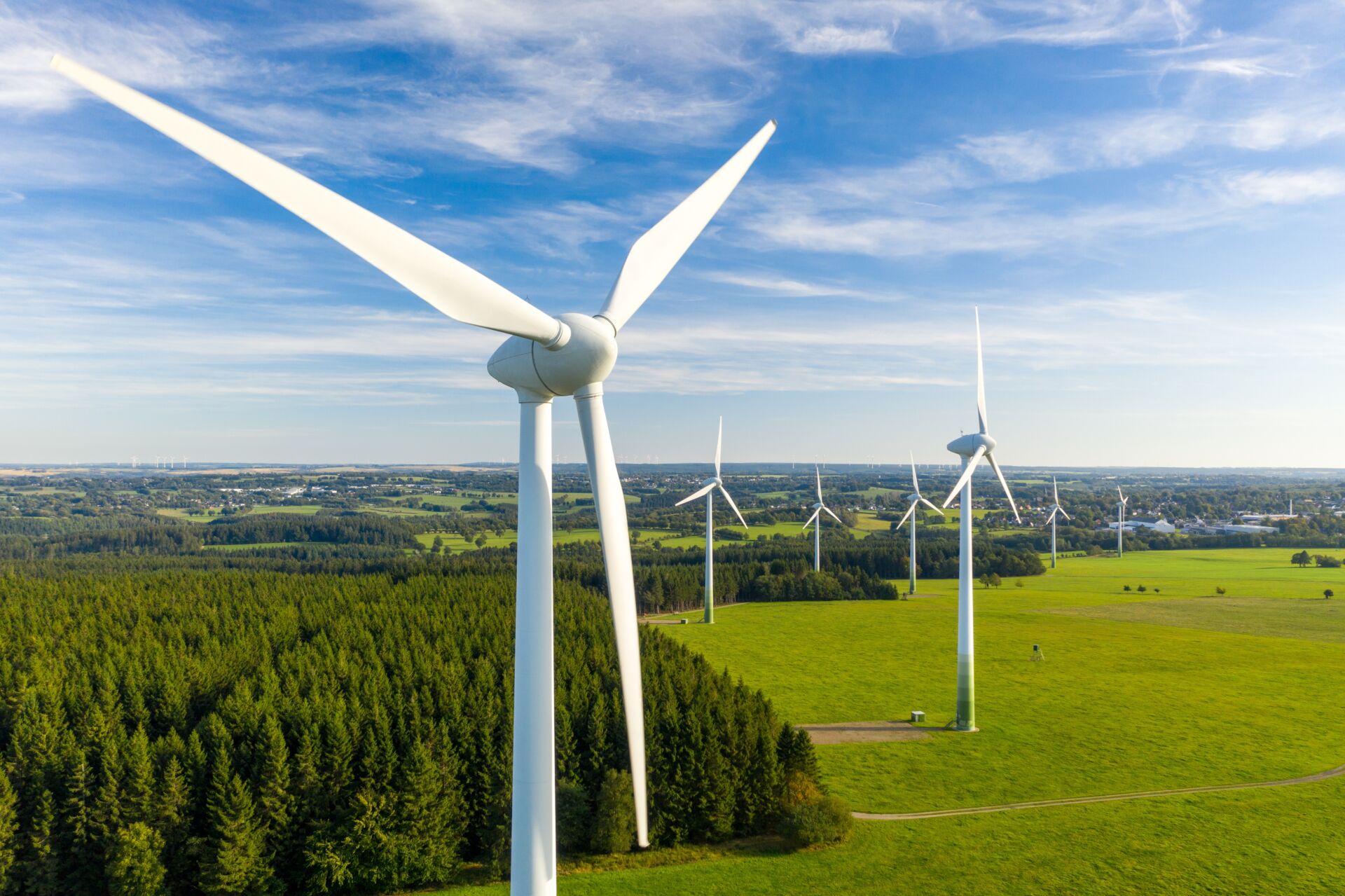This Canstar Blue guide discusses your options for going green with your energy in Australia. Read on for more information about GreenPower plans, carbon neutral energy options and the benefits of solar power.
At this stage, it’s safe to say we’ve probably all heard about the negative carbon footprint of our electricity generation and usage, but for the modern day Aussie, it’s hard to get around our reliance on the grid. One of the big questions that might spring to mind is whether there’s a way to use power that could be categorised as ‘environmentally friendly’ – and if so, what changes would the everyday energy consumer have to make to fit the bill?
If you’re a keen, green, eco-conscious machine, and are looking for the best green electricity options available to fit your needs, then you’ve come to the right place – we break down the steps to get you on your way to greener pastures (literally).
On this page:
Can I buy green energy in Australia?
Let’s clear the air – unless you’re producing electricity yourself with solar panels, there’s no way Aussie customers can purchase green energy that is entirely generated from renewable sources. This is because our energy all feeds into one single source, from which it is then distributed based on states and other location-specific details. So, power generated from wind turbines, hydro electric stations, or huge solar farms is all fed into the same electricity grid as power generated from gas or coal-fired plants across the country. There is no way of knowing the origin of the energy used in your home – unless, of course, it’s drawn straight from the solar panels on your roof.
The current shift from fossil fuels to cleaner green energy (largely through public pressure) has pushed corporations and governments to invest in renewable energy generation that will help power our energy grids with solar, wind and hydro energy amongst other renewable resources, and move away from non-renewable methods. Until this is the case, there are a few things you can do to lessen the environmental impact of your power usage.
What are my green energy options in Australia?
Here are the green energy options available to Australians who want to reduce their carbon footprint:
Option 1: Pay extra for GreenPower
GreenPower is a government program that allows everyday Aussies to opt in to pay a bit extra on their energy bill in order to support investment in renewable energy. How it works is that you’ll pay a few dollars a week on top of your normal electricity payments to have between 10% and 100% of your electricity usage offset through the purchase of Large-scale Generation Certificates. So, your provider essentially pays for a certain amount of renewable energy to enter the grid on your behalf. Though really, you’re paying for it!
Electricity plans with GreenPower add-on options
Below are some of the plans on our database that offer the option of GreenPower. The cost and percentage of GreenPower may vary between each deal. See provider websites for further details.
Here are some of the cheapest published deals from the retailers on our database that have a GreenPower option and include a link to the retailer’s website for further details. These are products from referral partners†. These costs are based on the Ausgrid network in Sydney but prices may vary depending on your circumstances. This comparison assumes general energy usage of 3900kWh/year for a residential customer on a single rate tariff. Please use our comparison tool for a specific comparison in your area. Our database may not cover all deals in your area. As always, check all details of any plan directly with the retailer before making a purchase decision. The annual cost estimates for the plans below may not include the cost of GreenPower. The extra cost of GreenPower may vary between retailers.
Here are some of the cheapest published deals from the retailers on our database that have a GreenPower option and include a link to the retailer’s website for further details. These are products from referral partners†. These costs are based on the Citipower network in Melbourne but prices may vary depending on your circumstances. This comparison assumes general energy usage of 4000kWh/year for a residential customer on a single rate tariff. Please use our comparison tool for a specific comparison in your area. Our database may not cover all deals in your area. As always, check all details of any plan directly with the retailer before making a purchase decision. The annual cost estimates for the plans below may not include the cost of GreenPower. The extra cost of GreenPower may vary between retailers.
Here are some of the cheapest published deals from the retailers on our database that have a GreenPower option and include a link to the retailer’s website for further details. These are products from referral partners†. These costs are based on the Energex network in Brisbane but prices may vary depending on your circumstances. This comparison assumes general energy usage of 4600kWh/year for a residential customer on a single rate tariff. Please use our comparison tool for a specific comparison in your area. Our database may not cover all deals in your area. As always, check all details of any plan directly with the retailer before making a purchase decision. The annual cost estimates for the plans below may not include the cost of GreenPower. The extra cost of GreenPower may vary between retailers.
Here are some of the cheapest published deals from the retailers on our database that have a GreenPower option and include a link to the retailer’s website for further details. These are products from referral partners†. These costs are based on the SA Power network in Adelaide but prices may vary depending on your circumstances. This comparison assumes general energy usage of 4000kWh/year for a residential customer on a single rate tariff. Please use our comparison tool for a specific comparison in your area. Our database may not cover all deals in your area. As always, check all details of any plan directly with the retailer before making a purchase decision. The annual cost estimates for the plans below may not include the cost of GreenPower. The extra cost of GreenPower may vary between retailers.
A common misconception of GreenPower is that you’re directly purchasing green energy from renewable sources, but since electricity comes from the national grid rather than any one single energy generation source, purchasing this add-on is the closest customers without solar can get to actually using renewable electricity. Not all energy companies offer GreenPower, but here are the ones that do, Please note, some of the companies may not be currently accepting new customers:
- ActewAGL
- AGL
- Amber
- Aurora Energy
- CovaU
- Diamond Energy
- Discover Energy
- Dodo
- EnergyAustralia
- Engie (formerly Simply Energy)
- Ergon Energy
- Energy Locals
- Ergon Energy
- Momentum Energy
- Nectr
- Origin
- OVO Energy
- Powershop
- Radian Energy
- ReAmped Energy
- Red Energy
- Synergy
How much does GreenPower cost?
The cost of GreenPower varies between providers, and the percentage of GreenPower you choose to purchase. The availability of GreenPower varies between states and plans, so be sure to check with your retailer to see what’s available to you.
| Provider | % GreenPower offered* | How much will this cost me? |
|---|---|---|
| ActewAGL | 10%, 25%, 50%, 100%, 200% | 5.5c/kWh |
| AGL | 20%,100% | $1/week or 4.4c/kWh |
| Amber Electric | 100% | 5.62c/kWh |
| Aurora Energy | 10%, 20%, 50%, 75%, 100% | 0.602c/kWh to 6.023c/kWh |
| CovaU | 25%, 50%, 100% | 1.1c/kWh to 4.4c/kWh |
| Diamond Energy | 50%, 100% | 2.75c/kWh to 5.5c/kWh |
| Dodo | 10%, 100% | 0.99c/kWh to 9.9c/kWh |
| Energy Locals | 10%, 50%, 100% | 0.39c/kWh to 3.9c/kWh |
| EnergyAustralia | 10%, 20%, 100% | 10% of total kWh X 4.95c 20% of total kWh X 4.95c 100% of total kWh X 4.95c/kWh |
| Ergon Energy | 10%, 25%, 50%, 75%, 100% | $10 to $100/quarter |
| Lumo Energy | 10% | 4.84c/kWh |
| Origin | 25%, 50%, 100% | $1.09/week to $4.33/week |
| OVO Energy | 100% | 4.95c/kWh |
| Powershop | 100% | 5.5c/kWh |
| Red Energy | 100% | 4.84c/kWh |
| Simply Energy | 100% | 50c/day |
| Synergy | 25%, 50%, 75%, 100% | $10 to $80 per billing cycle |
*Information sourced from GreenPower.gov.au and retailer fact sheets/websites, March 2023
Option 2: Choose carbon offset electricity
Put simply, ‘carbon offsetting’ is making up for the carbon emissions that you create through your electricity usage by supporting emission reduction efforts across Australia and the globe. Each provider has their own way of offsetting – which we’ll explore in more detail below. These are the companies offering carbon neutral energy options to Australians.
Providers that carbon offset energy in Australia
- AGL
- Alinta Energy
- Arcline by RACV
- EnergyAustralia
- Energy Locals
- Engie (formerly Simply Energy)
- GloBird Energy
- Origin
- Nectr.
Plans with carbon offset energy
Here are some of the cheapest published deals from the retailers on our database that have a carbon offset option available. These are products from referral partners†. These costs are based on the Ausgrid network in Sydney but prices may vary depending on your circumstances. This comparison assumes general energy usage of 3900kWh/year for a residential customer on a single rate tariff. Please use our comparison tool for a specific comparison in your area. Our database may not cover all deals in your area. As always, check all details of any plan directly with the retailer before making a purchase decision. The cost of carbon neutral programs may vary from retailer to retailer.
Here are some of the cheapest published deals from the retailers on our database that have a carbon offset option available. These are products from referral partners†. These costs are based on the Citipower network in Melbourne but prices may vary depending on your circumstances. This comparison assumes general energy usage of 4000kWh/year for a residential customer on a single rate tariff. Please use our comparison tool for a specific comparison in your area. Our database may not cover all deals in your area. As always, check all details of any plan directly with the retailer before making a purchase decision. The cost of carbon neutral programs may vary from retailer to retailer.
Here are some of the cheapest published deals from the retailers on our database that have a carbon offset option available. These are products from referral partners†. These costs are based on the Energex network in Brisbane but prices may vary depending on your circumstances. This comparison assumes general energy usage of 4600kWh/year for a residential customer on a single rate tariff. Please use our comparison tool for a specific comparison in your area. Our database may not cover all deals in your area. As always, check all details of any plan directly with the retailer before making a purchase decision. The cost of carbon neutral programs may vary from retailer to retailer.
Here are some of the cheapest published deals from the retailers on our database that have a carbon offset option available. These are products from referral partners†. These costs are based on the SA Power network in Adelaide but prices may vary depending on your circumstances. This comparison assumes general energy usage of 4000kWh/year for a residential customer on a single rate tariff. Please use our comparison tool for a specific comparison in your area. Our database may not cover all deals in your area. As always, check all details of any plan directly with the retailer before making a purchase decision. The cost of carbon neutral programs may vary from retailer to retailer.
EnergyAustralia (Go Neutral)
![]()
EnergyAustralia offers customers the opportunity to opt in to its Go Neutral product and have their carbon emissions offset through the purchase of carbon offset units. EnergyAustralia buys carbon offset units that meet the government’s Climate Active Carbon Neutral Standard. The types of projects it supports include renewable energy construction in developing countries, bushfire management, protecting native forests from land clearing and improving business energy efficiency.
Energy Locals (Carbon Offsets)
![]()
Energy Locals claims to carbon offset 100% of the electricity usage of all its retail and business members through the purchase and surrender of carbon credits. Energy Locals does not explicitly state where its carbon credits are purchased from, however its website cites them as ‘international carbon credits’.
AGL (Carbon Neutral Opt-In)

AGL has an initiative that includes a product that’s certified as Climate Active Carbon Neutral. This is an opt-in program whereby customers pay $1 per week to have their home’s carbon emissions offset through emissions reduction projects. Currently, the energy retailer is supporting a NSW native forest regeneration program and a Kenyan initiative that provides communities with energy efficient stoves. For an additional 50c a week, customers can also have their gas usage offset.
Origin Energy (Go Zero)

Origin purchases carbon offsets for its customers’ electricity usage through its Origin Go Zero Electricity add-on, a product which is certified carbon neutral by Climate Active. This is an opt-in product with the retailer and comes at an additional cost of $1.50 per week. Add this opt-in product to your electricity plan, and Origin will ensure the same amount of greenhouse emissions created by your electricity use is offset.
This add-on option is also available on natural gas and LPG plans through Origin Go Zero Natural Gas and Origin Go Zero LPG. Origin Go Zero Natural Gas is priced at an extra $1.00 per week, while Origin Go Zero LPG costs are related to the size of your LPG bottle or refill order.
Nectr (100% Clean)
![]()
Nectr offers carbon offsets on all its energy plans. Its 100% Clean plan includes an opt-in product that’s certified Climate Active Carbon Neutral, thanks to its buying of carbon offset certificates/units from both local and international projects.
Engie (Carbon Neutral Energy)
Engie (formerly Simply Energy) is offering to offset emissions of its customers’ energy usage, with the company matching their emissions with the purchase of certificates from energy generation projects that absorb or abate the production of CO2. Certificates are claimed to be sourced from activities that meet the Climate Active Carbon Neutral Standard’s offset eligibility criteria.
GloBird Energy (GloGreen)

GloBird Energy offsets emissions for customers on its latest product ‘GloGreen’. This electricity plan is claimed by the retailer to be 100% carbon neutral. According to the GloBird Energy website, the retailer offsets customers’ emissions on this product by purchasing the following: Certified Emissions Reduction (CERs) certificates, Verified Emission Reductions (VERs), Verified Carbon Units (VCUs) and Australian Carbon Credit Units (ACCU).
Arcline by RACV (Carbon Offset Energy)
![]()
Arcline by RACV purchases and surrenders carbon emission units on behalf of its customers through Certified Emission Reductions (CERs), recognised under the National Carbon Offset Standard (NCOS). According to its website, Arcline by RACV purchases units equal to the total energy it anticipates its customers to use each year, in advance. However, it does state that it purchases additional certificates if its customer use more energy than forecasted. Please note, Arcline by RACV currently only services customers in Victoria.
Alinta Energy (Carbon Balance)

Alinta Energy purchases carbon offsets for customers’ emissions through its new Carbon Balance product. These offsets are eligible under the Climate Active Carbon Neutral Standard. Alinta Energy claims that all the projects it supports through this program are Australian-based.
Option 3: Consider installing a solar system
One of the easiest ways to reduce your eco footprint is to use less electricity from the grid. Solar panels can be an intimidating upfront investment, but with so many installers now offering payment plans, it might be a price worth paying. And with the option to store the extra electricity your panels generated in the daytime in a battery, you could find yourself in a position to go completely off-grid.
We’ve got solar pretty well covered at Canstar Blue, so you can rest assured you’re well educated before making any big purchasing decisions.
Solar Power FAQs
How can I reduce my carbon footprint when it comes to green energy?
It goes without saying that the easiest and most cost-effective way to reduce the negative effects of your energy usage is to… use less electricity. But unfortunately for the majority of Australians who live in big cities, this may seem like an impossible task. At Canstar Blue, we’ve shared our best tips and tricks for maximum energy-efficiency, helping you cut down both your power bill and your carbon footprint.
Is it financially ‘worth it’ to switch to green energy?
Going green doesn’t have to cost an arm and a leg, and if you’ve made it this far down our page, there’s a good chance it probably is ‘worth it’ to you. From picking an energy provider that purchases carbon certificates on your behalf, to installing a full off-grid solar power system, there’s varying price points, but your decision will ultimately weigh on your personal circumstances. If you’re a budget-strict uni student, choosing an electricity retailer that supports carbon-reducing products may be the best you can realistically do, but if you’re further up the career ladder, forking out extra for a GreenPower plan or a solar system could be a great option.
If money is tight, keep in mind that savings can be found in the place where you might need it most. Shopping around for a good deal could save you hundreds a year – money that you can invest in green energy initiatives – so use our comparison tool below to start comparing green energy plans on Canstar Blue.
Image credit: engel.ac/shutterstock.com



Share this article